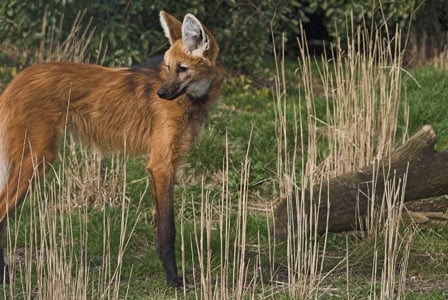
No, nobody taught a skulk of foxes how to use stilts. Learn about the maned wolf on this Wildlife Wednesday.
So, they’re not foxes and, just to make things confusing, maned wolves aren’t actually wolves, either. This dainty-legged creature actually has a genus all of its own (Chrysocyon).
Habitat
Maned wolves are found in the South American countries of Argentina, Bolivia, Brazil, Paraguay, and Peru. They can most often be found weaving their way through grasslands, wet fields, and woodlands with an open canopy.
Trivia
- Perhaps unsurprisingly, these long-legged wolves are the tallest canines in South America, measuring in around 35 in (90 cm) at the shoulder.
- Those comically long legs, though, do serve an important purpose, allowing maned wolves to see over the long grasses that make up their preferred habitat.
- The true masters of long-distance relationships, maned wolves are both monogamous and solitary. Breeding pairs only meet up during the mating season, and the only “packs” out there consist of mothers and pups.
- Although classified as carnivores, these tall tail-waggers share at least one thing in common with everyday dogs—they eat most everything they can find. Maned wolves normally eat birds and their eggs, reptiles, rodents and other small mammals, insects, bananas, guavas, the aptly named wolf apple, and (much to the chagrin of poultry farmers) chickens.
Why are they threatened?
Major threats to maned wolves include habitat loss due to conversion of fields to agricultural land, habitat fragmentation, and “altercations” between wolves and vehicles. Dogs also pose a threat to the wolves, as they may attack maned wolves and might also pass on diseases to them.

